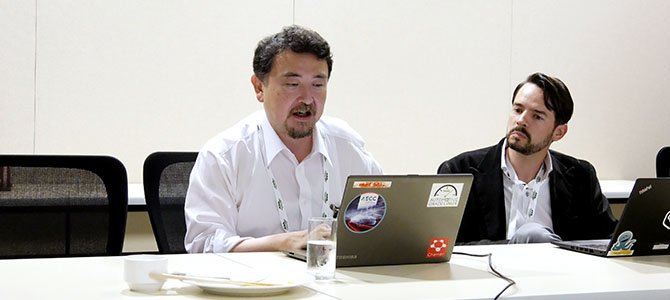More than 1,000 nerds, geeks, and hackers are convening in Tokyo this week to decide on the future of the automobile. Word got around that the car’s future is digital, and the conventioneers, meeting at the Tokyo Conference Center Ariake, are involved in writing your car’s operating system, called Automotive Grade Linux, or AGL.
Linux is what powers the website you are reading, Linux makes your phone work if you are using an Android device. A remote cousin of Linux drives your iPhone. If it is up to the conventioneers, Linux will be the standard operating system of future cars.
AGL’s annual summit is in Tokyo, and not in Silicon Valley, because the Japanese auto industry, led by Toyota, has put its considerable combined heft behind the undertaking. Today, I met the man who talked Toyota into becoming an open source champion.
Ken-ichi Murata, sporting his trademark Van Dyke beard, told me that AGL has long left the design labs. AGL already is in the Toyota Camry and in the new plug-in Prius, “and it will be in many more Toyota models to come,” Murata said. Sitting next to him, Thomas Wurdig of Daimler explained how AGL will become the brains of upcoming Mercedes vans.
Murata headed Sony’s Playstation3 development, and he was instrumental in moving the box to using open source software. Soon, clusters of Playstations were used by the U.S. military in lieu of Supercomputers. In 2008, Murata changed to Toyota, first as Global Chief Engineer of in-vehicle multi-media/telematics systems, and since 2015, as strategist of connected vehicles. It was Murata who convinced the carmaker to become the driving force behind the Automotive Grade Linux open source project, a huge change of mind for a company that usually tries to keep all strategic development in-house.
Dan Cauchy, Executive Director of Automotive Grade Linux at The Linux Foundation, said that AGL’s membership list has swelled to 127 members, the most prominent of the newcomers being Amazon. “Many of the world’s tier one companies, as well as most of the semiconductor providers to the automotive industry,” are card-carrying AGL: members, Cauchy said.
Initially, AGL’s work focused on the entertainment system, by now, instrument cluster and HUD profiles have become part of a new AGL release going by the NSA-worthy codename “Funky Flounder.” During the rest of the year, AGL maintainers will work (with heavy input by Amazon) on speech, vehicle to cloud, and virtualization. Virtualization will allow AGL to work side-by-side with legacy in-car solutions, such as Blackberry’s QNX system. Mild-mannered CPUs used in typical car applications, such as the ubiquitous quad-core ARM Cortex, have “ample power to run many things at once,” Cauchy assured me.
AGL also will leverage the investment into real time Linux to power future ADAS systems. As an open source system, automakers and suppliers can use AGL free of charge (free download), which should guarantee its ultimate success in a business that counts every penny going into a car. If you make 10 millions cars a year, that penny is worth $100,000.






